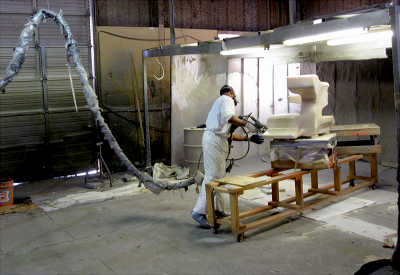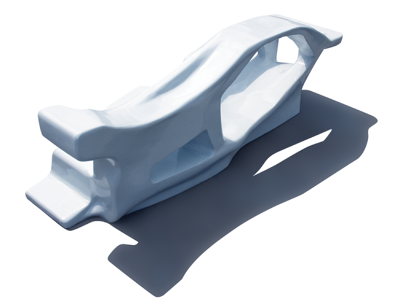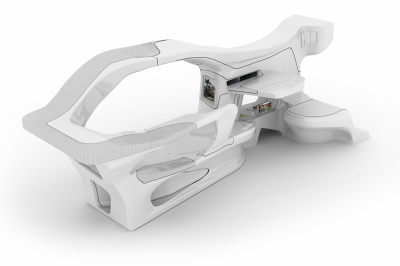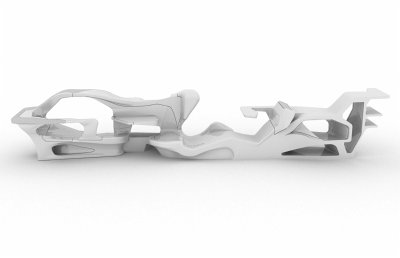
This is the first entry in what we plan on making a series of entries on studio work at WUSTL. To kick things off, here is a glimpse at one of 2 fabrication studios that were available to students at the option level this semester. Studio data, text and images to follow...but first, here is a link to studio web site, which showcases the team, their concept, process, and product: xl-tim.net
Make sure to check out the various galleries on the site, which show the numerous physical mock-ups and digital studies conducted.
Studio: TRANS:formable_BODIES
Instructor: Sung Ho Kim
Semester: Spring 2010
TRANS:formable_BODIES
The contemporary world renders our lives of total mobility and flexibility allowing us to become global nomads. This life of speed and data exchange blurs the boundary between personal leisure and productive activities. This studio will question and to explore an architecture of intimate scale and materiality through digital outputs.
We will develop an intermixing of performative parametric design with manufacturing techniques and existing infrastructural systems as design opportunities. Trans:formable Bodies are design processes that incorporate the totality of media and technology into an architectural interface of the body. All the projects in the studio will output working and functional prototypes in full scale.
DESIGN PROCESSES
_Development of programmatic attitudes of leisure and productive functions.
_Fabrication of surface geometries with body interface.
_Incorporation with media infrastructure and data integration.
_Manufacturing of prototypes.
_Interface with digital process with material process.
XL: T.I.M
XL: T.I.M (aka. Cross Lifestyle: Technologically Interfaced Module) is a design project brought by a group of graduate students of architecture at Washington University in St. Louis under Professor Sung Ho Kim, studying in modern social interaction with furniture. With the progression beyond the industrial revolution craftsmanship has been given a back seat to mass production and mass availability. Our culture has adapted and accepted mass production because of our demands relegated by technological advances: we want everything faster, easier and more efficient.
The goal of XL-T.I.M. is to question the hybridization our "bigger, faster, stronger" culture with craftsmanship, giving the user everything they need from the time they open the door to when they sleep and night, all in one integral piece of furniture.
process_proto type model in 1=1/3 scale
process_proto type model in 1=1/3 scale
final _proto type model
final _proto type model
_History
The timeless justification for quality furniture design stems from the human desire to develop an instrument to support ritualized daily activities. Before the advent of mechanized assembly, craftsmen were able to add value to these instruments through careful construction and meticulous design, meeting the desires of varying class levels. The advent of mass production made quality design more easily available to more people, but lessened the role of the craftsman.
At the same time, lifestyle shifts and technological advancements have transformed the possibilities of furniture design as an instrument for both productivity and leisure. Mass-production has given way to mass-customization and rapid prototyping, lessening the restrictions placed on modern designers/craftsmen. Combined with unprecedented material availability, modern assembly techniques provide possibilities, but do not supplant the craftsmanship of the designer. Properly manipulated, current technologies provide a remarkable opportunity for timeless craft ideals to be reinvigorated and applied to to furniture as a lifestyle support instrument.
_Body Interface
Modern daily routines continue to transform rapidly, necessitating a reevaluation of what role furniture plays in productivity and leisure as well as potential hybrid scenarios. By studying the natural body mechanics of basic daily routines, a baseline was established to evaluate contemporary body positioning in terms of comfort, efficiency, and technological interfacing.
Coupled with historical investigations and future potentials in furniture use, key body interface moments were developed and refined as an evaluation of contemporary societal values and high-speed daily routines. Ergonomic considerations were furthered through investigations of materiality, lighting, and spatial integration to temper the design as an extension of modern cross-lifestyles.
rendering of the final model 
rendering of the final model (physical proto type currently under construction)
Thanks to Shin in Sung Ho's studio for gathering the content for this post! In case you missed the link above, here it is again: xl-tim.net
Thanks for reading,
Aaron
1 Comment
AP, I was wondering where you were. I'm totally ashamed that I just figured out you were blogging and have been in school for almost a year now. I guess we all have our own crazy lives to worry about. :o/
A belated "Welcome" to the Archinect School Blogs, MK! :o)
Block this user
Are you sure you want to block this user and hide all related comments throughout the site?
Archinect
This is your first comment on Archinect. Your comment will be visible once approved.